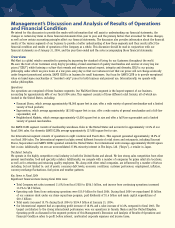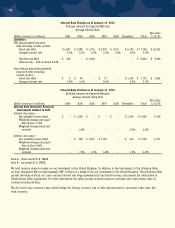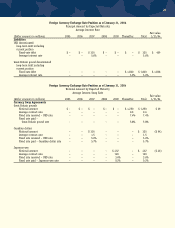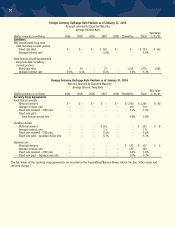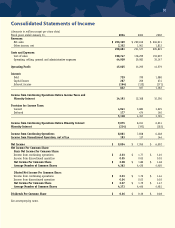Walmart 2004 Annual Report Download - page 25
Download and view the complete annual report
Please find page 25 of the 2004 Walmart annual report below. You can navigate through the pages in the report by either clicking on the pages listed below, or by using the keyword search tool below to find specific information within the annual report.
Fiscal 2004 sales at our United Kingdom subsidiary, ASDA, made up 45.6% of the International segment net sales. Sales for ASDA
included in the Company’s consolidated income statement during fiscal 2004, 2003 and 2002 were $21.7 billion, $18.1 billion and
$15.3 billion, respectively.
The fiscal 2004 increase in segment operating income as a percentage of segment sales compared with fiscal 2003 resulted from a 0.4%
improvement in gross margin offset by increases in operating expenses primarily due to the adoption of EITF 02-16. Under EITF 02-16,
certain vendor funding was previously accounted for as a reduction of expenses, but is now accounted for as a reduction of inventory
purchases. The improvement in gross margin was due to an overall increase as a percentage of the segment’s net sales in general
merchandise sales which carry a higher margin.
The fiscal 2003 increase in segment operating income as a percentage of segment sales resulted from a 0.4% improvement in gross
margin from fiscal 2002 and a 0.8% reduction in operating expenses as a percentage of segment sales compared with fiscal 2002. The
adoption of FAS 142 affected the comparison of operating income between fiscal 2003 and fiscal 2002 because, in accordance with
FAS 142, we did not record any goodwill amortization expense during fiscal 2003. If the International segment expenses for fiscal 2002
were adjusted to remove the goodwill amortization expense recorded for that period (that would not have been recorded if FAS 142 had
been in place in fiscal 2002), the reduction of operating expenses as a percentage of segment sales for fiscal 2003 compared with fiscal
2002 would have changed from the 0.8% reduction discussed above to a 0.2% reduction. Furthermore, the International segment’s
operating income in fiscal 2002 would have increased $216 million to $1.5 billion for fiscal 2002. If FAS 142 had been effective in fiscal
2002, the International segment’s operating income increase from the prior fiscal year would have been reduced from 57.2% to 34.4%.
Our financial results from our foreign operations could be affected by factors such as changes in foreign currency exchange rates, weak
economic conditions, changes in tax law and government regulations in the foreign markets in which the Company does business. The
Company minimizes exposure to the risk of devaluation of foreign currencies by operating in local currencies.
Summary of Critical Accounting Policies
Management strives to report the financial results of the Company in a clear and understandable manner, even though in some cases
accounting and disclosure rules are complex and require us to use technical terminology. We follow generally accepted accounting
principles in the United States in preparing our consolidated financial statements. These principles require us to make certain estimates
and apply judgments that affect our financial position and results of operations as reflected in our financial statements. Management
continually reviews its accounting policies, how they are applied and how they are reported and disclosed in our financial statements.
Following is a summary of our more significant accounting policies and how they are applied in preparation of the financial statements.
Inventories
We value our inventories at the lower of cost or market as determined primarily by the retail method of accounting, using the last-in,
first-out (“LIFO”) method for substantially all U.S. merchandise inventories, except SAM’S CLUB merchandise, which is based on average
cost using the LIFO method. Inventories for foreign operations are primarily valued by the retail method of accounting and are stated
using the first-in, first-out (“FIFO”) method.
Under the retail method, inventory is stated at cost, which is determined by applying a cost-to-retail ratio to each merchandise
grouping’s retail value. The cost-to-retail ratio is based on the fiscal-year purchase activity for each store location. The retail method
requires that Management make certain judgments and estimates that may significantly impact the ending inventory valuation at cost,
as well as the amount of gross margin recognized. The judgments made include the recording of markdowns used to sell through
inventory and shrinkage. Markdowns designated for clearance activity are recorded at the time of the decision rather than at the point
of sale, when Management determines the salability of inventory has diminished. Factors considered in the determination of markdowns
include current and anticipated demand, customer preferences, age of merchandise, as well as seasonal and fashion trends. Changes in
weather patterns and customer preferences related to fashion trends could cause material changes in markdowns year over year.
The Company records a LIFO provision each quarter for the estimated annual effect of inflation, and these estimates are adjusted to
actual results determined at year-end. Our LIFO provision is calculated based on inventory levels, markup rates and internally generated
retail price indices except for grocery items, for which we use a consumer price index. Our accumulated LIFO reserve pertains to grocery
items and is immaterial to our financial statements.
The Company provides for estimated inventory losses (shrinkage) between physical inventory counts on the basis of a percentage of
sales. The provision is adjusted annually to reflect the historical trend of the actual physical inventory count results. Historically,
shrinkage has not been volatile.
Impairment of Assets
We evaluate long-lived assets other than goodwill for indicators of impairment under the provisions of Financial Accounting Standards
Board Statement No. 144, “Accounting for the Impairment of Disposal of Long-Lived Assets,” whenever events or changes in
23







